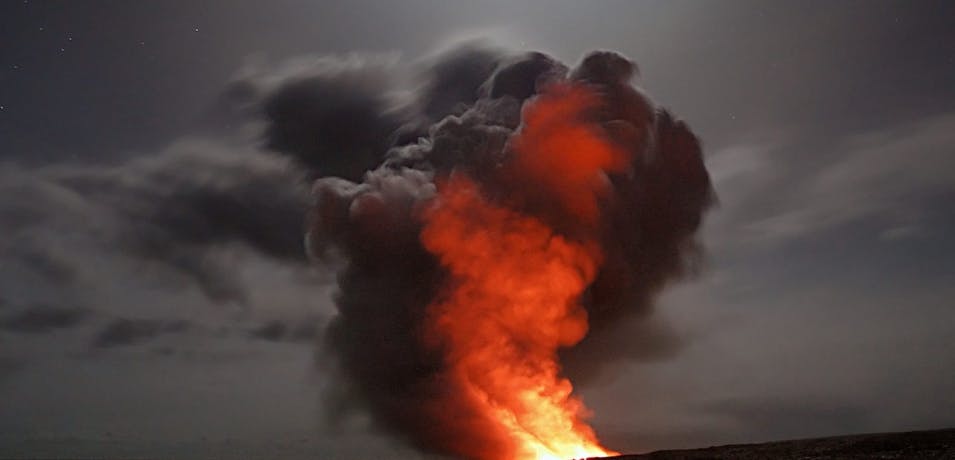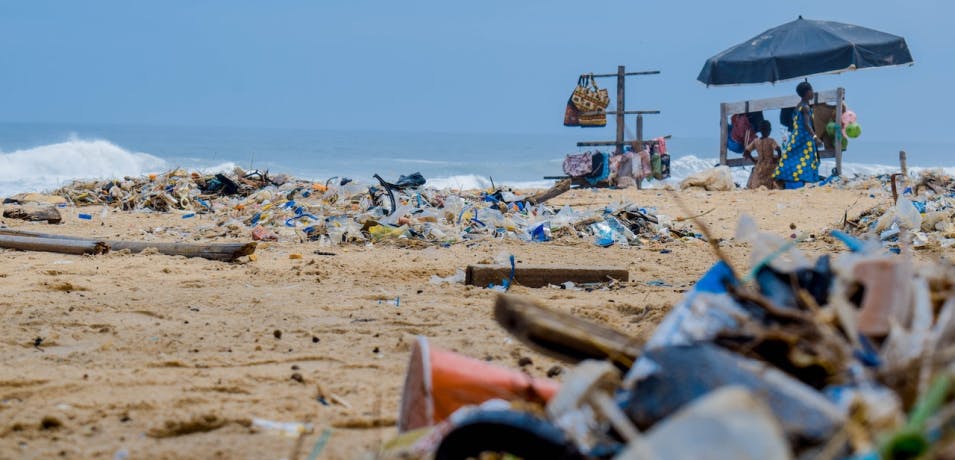ESG / CSR
Industries
All you Need to Know about the 9 Planetary Boundaries



In early May 2022, many of us were peacefully basking in the sun, while the sixth planetary boundary in the earth system was being broken, met with general indifference. This means that six planetary boundaries out of nine have now been crossed. The figure was updated in early May by researchers and scientists. And this is not a small deal, trust us.
But what does this all mean?
In an effort to protect our home (planet Earth, remember), the scientific community has managed to establish environmental thresholds, illustrating the capabilities of the earth to meet all our needs. These earth system processes are known as planetary boundaries. And their finding is unambiguous: we are in a mess.
But what on earth are we talking about?
Learn all about the nine planetary boundaries that can't be crossed.
Planetary boundaries: what are they all about?
In practice, a planetary boundary is also intended to serve as a benchmark, to help humanity develop and prosper without threatening its ecosystem or sacrificing biosphere integrity.
With this in mind, two types of thresholds have been established: a safety threshold and a risk threshold. If the latter is exceeded, major climate disruptions are to be expected - unfortunately sometimes irreversible and aren't control variables.
To put it simply, planetary boundaries framework identifies the planetary boundaries concept as as defining a safe and sustainable development perimeter. Defying this threshold is equivalent to threatening our survival through a land system change and that of other species. This is a blunt statement, but it is a fact. And it's downright scary, when you consider that we've already defied six out of nine limits, right?
There are nine biophysical processes - seven core boundaries of which are framed by quantitative thresholds - moreover in constant interaction:
- climate change, such as national environmental footprints and excessive greenhouse gas emissions;
- ocean acidification and marine biological systems;
- stratospheric ozone depletion;
- disruption of the nitrogen and phosphorus cycle;
- global water use;
- land use change;
- erosion of biodiversity;
- the increase of aerosols and existing substances in the atmosphere such as synthetic chemicals ;
- the introduction of new entities into the biosphere.
Resource scarcity (fossil fuels and mineral resources) are not part of the planetary limits for the simple reason that it is not considered a threat to human life.
In addition, planetary boundaries are established as strategic objectives to ensure a global balance and overall earth system functioning. In addition to informing the general public, environmental boundaries allow for the assessment of interactions between different domains, and they provide a comprehensive and cross-cutting view of planetary risks.
Let us be clear, the consequences of exceeding these thresholds do not result in a large-scale and immediate catastrophe, but in small consequences to vital earth system processes that appear little by little and deeply disrupt the ecosystem.

How were environmental limits established?
Now that you know what this is all about, let's look at the origins of planetary limits. Why were these planetary boundaries established?
2000: opening a new geological epoch
We have left the Holocene era and entered the Anthropocene era - a term first coined in 2000 by biologist Eugene F. Stoermer and Nobel Prize-winning chemist Paul Crutzen.
Of course, there have always been climate variations, but the climate change we are facing is more rapid and intense than previous ones. Why?
- the industrial revolution that has caused industrial chemicals and greenhouse gas emissions that exceed the pre industrial level;
- economic development;
- the intensification of human activities, human modification, and human societies - and therefore the increased use of natural resources - linked to population growth.
The phenomenon, theorized in 2005 by Will Steffen and Paul Crutzen, has a name: the Great Acceleration, which leads to an accumulation of greenhouse gases in the atmosphere, as well as other disastrous repercussions for our ecosystem.
In short: through the use of environmental science to understand the earth system process boundaries, it is clear that we can no longer turn a blind eye to climate change.
2009: The appearance of the concept of "planetary boundaries"
These major climate variations cannot - and should not - go unanswered. In 2009, a team of 26 researchers from the Stockholm Resilience Centre - led by Johan Rockström and Will Steffen - developed and defined planetary boundaries in their paper "Planetary Boundaries: Exploring the Safe Operating Space for Humanity."
At the time, the study revealed that three other planetary boundaries had already been crossed: climate change, biodiversity loss, and disruption of the nitrogen and phosphorus cycle.
This scientific concept is a continuation of the work of the Club of Rome, through the report "The Limits to Growth" - known as the Meadows Report - of 1972. The latter pointed the finger at the development model based on infinite growth with limited resources.
2015: The first study is updated
In 2015, the 2009 study was updated and entitled "Planetary boundaries: Guiding human development on a changing planet."
The revision of the conceptual model now incorporates a ninth boundary: the introduction of new entities into the environment. In addition, the study now demonstrates that the threshold for changing land systems has now been exceeded.
2022: Two new thresholds are crossed
The damage continues. In January 2022, the introduction of new entities into the biosphere - in other words, chemical production cause by excessive pollution - becomes the fifth threshold to be exceeded.
This is followed, in April 2022, by the crossing of a sixth: that of the freshwater cycle. According to the study conducted by Johan Rockström and published in the journal 'Nature', this resource is in fact "largely disrupted by human pressures on a continental and global scale".

The nine planetary limits in detail
Climate Change
If you are a regular reader of our blog, you know the concept of climate change inside and out! But a little reminder never hurts.
Climate change is characterized by an increase in the concentration of greenhouse gases in the atmosphere, caused by human activities. In other words, persistent organic pollutants, the use of fossil fuels, the use of synthetic fertilizers or the production of artificial GHGs disrupt the fragile climatic balance.
Changes worth noting include:
- a rise in temperatures on a planetary scale ;
- an acidification of the oceans
- a massive destruction of biodiversity;
- an increase in food crises;
- an increase in extreme weather phenomena making life on earth more and more difficult - for plants and animals, as well as for humans.
According to the Paris Agreement, it is necessary to keep the global temperature increase below 2°C - ideally 1.5°C above pre-industrial levels.
As such, this global limit is calculated based on the concentration of CO2 in the atmosphere. The threshold must be below 350 ppm (parts per million). However, we are currently at 412 ppm.
Ocean acidification
Main carbon sinks - the oceans have been absorbing a quarter of the emissions since the industrial revolution - the oceans transform CO2 into carbonic acid.
Nevertheless, absorbing too much carbon emissions increases the ocean's acidity level, jeopardizing marine diversity, while compromising the oceans' ability to absorb more CO2.
In addition, this excess carbon in the atmosphere is - in effect - absorbed by living things, affecting species reproduction, marine ecosystems and the food chain.
This global limit is set according to the aragonite saturation rate, which must not fall below 80% - compared to its level in the pre-industrial era. In 2009, this limit is at 84% and therefore not yet exceeded. Unfortunately, following the same rate until 2050, saturation is expected to reach the much feared 80%.
Stratospheric ozone depletion
Stratospheric ozone is the layer of the atmosphere between 20 and 50 km above sea level that protects living things by filtering out much of the UV radiation.
Its thinning - even its disappearance - is a catastrophe for terrestrial life (skin cancers and modification of the photosynthesis system of plants).
For this reason, the concentration of ozone in the atmosphere is set at 275 DU (Dobson Unit), knowing that the average value of the ozone column is 300 DU.
However, in 2009, the concentration reached 283 DU.
Another piece of good news - too rare not to mention - is that the World Meteorological Organization says the ozone layer has been recovering at a rate of 1 to 3 percent per decade since 2000.
The layer over the Northern Hemisphere is expected to fully recover by 2030, while the layer over the Southern Hemisphere will recover by 2050 and by 2100 for the polar regions.
Disruption of the biogeochemical cycle of nitrogen and phosphorus
Nitrogen and phosphorus are essential naturally occurring elements and nutrients for plant growth. However, when emitted in large quantities, they become harmful to the environment, contributing to global environmental change and provoking earth system thresholds such as water pollution by nitrates - nitrogen - leading to eutrophication of freshwater - phosphorus - and causing anoxia in the oceans and the proliferation of green algae.
Thus, the limit of nitrogen is located between 62 and 82 million tons (Mt) per year, discharged on a global scale.
A limit exceeded in 2015 with losses of nitrogen estimated at 150 Mt. As for phosphorus, there are two thresholds:
- if it is released into water (agricultural surplus and wastewater), the threshold is 11 Mt per year. It was also exceeded in 2015 with 22 Mt discharged;
- if there is a phosphorus surplus due to excessive inputs during agricultural soil fertilization, the threshold is between 6.2 and 11.2 Mt per year. The limit was crossed in 2015 with 14 Mt.
At the current rate, natural phosphorus reserves will be exhausted in 50 to 100 years.
Global water use
Unevenly distributed on the planet - and representing only 3% of the world's water - freshwater is essential for our survival and that of living beings (plants, animals, etc.). However, water withdrawals have accelerated during the 20th century, particularly for agriculture and industrial uses. As an illustration, the share of the annual renewable freshwater resource withdrawn to serve human activities (or rain-fed agriculture) increased from less than 2% to 10% during the 20th century.
This planetary limit also takes into account green water, which is taken up by plants - and thus by terrestrial carbon sinks.
It's not surprising that this limit is exceeded, given our catastrophic water use...
A figure? The amount of renewable water that can be used without compromising ecosystems is set at 400 km3 of fresh water per year on a global scale.
You might want to sit down for this one: we are currently withdrawing 2600 km3 of water per year.
This human alteration of the water cycle is likely to disrupt the entire planet. Worse, in its latest report, the IPCC states that the water cycle is already at "a rate greater than anything we have experienced during the geological Holocene epoch." As an example, many Amazon regions are at risk of becoming savannahs.
Land use change
Land use change encompasses the transformation of natural and semi-natural environments into agricultural land.
In other words, the deployment of human activities on natural surfaces has serious consequences for the environment:
- the deforestation of large areas of forest ;
- the loss of biodiversity ;
- soil erosion;
- the increase of GHG emissions;
- Decrease in CO2 storage capacity;
- carbon depletion;
- risk of flooding.
The threshold here refers to the percentage of forest area retained, compared to the pre-1700 forest cover. As such, instead of having 75% of formerly forested land still forested, there is now only 62%.
The erosion of biodiversity
The erosion of biodiversity - that is, living things, ecosystems, and living species - involves increasing the rate of species extinction. This involves:
- the degradation of their habitat and ecological systems ;
- the destruction and fragmentation of natural environments due to human activities preventing global sustainability
- the pollution of these habitats;
- the overexploitation of wild species (overfishing or deforestation);
- the introduction of invasive exotic species;
- climate change.
This boundary includes two types of diversity:
- genetic diversity, which represents the variety in genes within a single species;
- functional diversity (not quantified), which symbolizes the variety of life forms and the interactions between them: such as aquatic systems, marine mammals, and other modified life forms.
We are now witnessing the sixth mass extinction on earth with a speed and intensity never seen before.
In the face of these disastrous impacts, the threshold not to be exceeded is 10 out of a million species extinctions per year.
You think this number is unattainable? Think again, as the limit was crossed in 2009 with 100 extinctions out of a million species.
The increase of aerosols in the atmosphere
Contrary to what we think, aerosols are mostly fine particles of an organic nature suspended in the air - solid, liquid or mineral (dust, spray, soot or eroded rock).
However, human activity has created toxic and processed aerosols (primary or secondary) that are harmful to our health, as well as to the environment.
Pollution research shows that accumulation of particles from aerosols increases the opacity rate of the atmosphere, leading to 10-15% of solar radiation at the earth's surface. In addition, the black carbon and organic carbon present in the composition of processed aerosols lead to global warming.
Despite its preponderant importance in global warming, it is impossible to quantify a threshold that should not be exceeded. Why? The complexity of aerosols, the spatio-temporal variability of particles, sources and impacts.
The introduction of new entities into the biosphere (chemical pollution)
It is about quantifying the pollution created or introduced by Humans in the biosphere (new chemical substances, nanomaterials and plastic polymers among others). This introduction is considered a planetary limit since it has three adverse effects:
- on the physiological development of man ;
- on the functioning of ecosystems;
- on other planetary limits (biodiversity erosion and climate change in particular).
In order to set a threshold, it is necessary to know the impact of exposure to the various substances on organisms and in the environment. However, given the large quantity of chemicals in circulation, defining a limit is impossible. Nevertheless, this global boundary is not left without a solution! Indeed, two approaches have been developed:
- focus on persistent pollutants with global impacts;
- to identify the long-term and large-scale adverse effects of chemical pollution on living organisms.
As a side note, plastic weighs twice as much as all the animals on earth and we ingest 2000 particles of microplastic every week.

Carbon footprint calculation: a concrete action to fight global warming.
France is gradually becoming aware of its environmental impact, notably through several commitments and publications - we can mention the state of the environment report and the environmental balance sheet. You can act at your level and contribute to the respect of the thresholds set for the remaining planetary limits!
Call our experts now to reduce your company's CO2 emissions (and save money)!


